There’s something deeply, fundamentally perverse about filming a Jack London story with CGI animals—it’s akin to shooting a film version of James Joyce’s Ulysses on location…in Belfast. Everything that the novel stood for—the ego destruction of modernist man in the face of antediluvian wilderness, the rediscovery of all that is untamed and untrammeled in our basest instincts—seems violated by the decision to forgo training and working with real flesh-and-blood animals. Equally obscene was the decision to shoot the film on sound stages in sunny California thousands of miles from the Yukon wilds rhapsodized by London. How seriously can we take a film about rediscovering the wonder and necessity of nature if we remove all the actual nature from said film?
This might seem like nitpicking, but it speaks to the major disconnection at the heart of Chris Sanders’ The Call of the Wild—it’s a film of incessant, baffling compromise, not just with its use of CGI effects but in how it approaches its material. Though cherished as one of the great American adventure novels—particularly among younger readers—London’s story of Buck, a spoiled St. Bernard mix that gets kidnapped from the American South, sold into a life of servitude as an Alaskan sled dog, and reborn as a member of a wolf pack is equal parts thrilling and brutish, redolent of the harsh cruelty of nature and the more monstrous side of humanity. London’s novel is full of graphic animal abuse, none more painful to read than when Buck gets taught the “law of the club” by the “man in the red sweater” when first kidnapped. Later we read as Buck’s fellow sled dogs get starved, mistreated, overworked, and shot by arrogant masters. The humans themselves fare little better—many either drown or get murdered by Native Americans.
Yet nearly all this unpleasantness is carefully brushed aside in the name of crowd-pleasing, family-friendly theatrics. There’s only one scene with the “man in the red sweater” and his abuse takes place largely off-camera. Buck’s fellow sled dogs never die, they simply “run off” while off-screen. Even the animal fights are remarkably chaste with nary a drop of blood shown in battles between beasts with long claws and even longer fangs. In his zeal to create PG-rated entertainment, Sanders has created a completely anesthetized wilderness that never comes across as truly dangerous. And therefore, it never comes across as truly wondrous either.
The question then remains whether or not The Call of the Wild succeeds as simple entertainment; if one can ignore the improprietous reworking of the source material and its messages, can one enjoy the film on its own merits? The answer is a solid “mostly.” It’s a decently paced, emotionally resonant adventure that features some truly moving performances. The film world reacted with a collected eye roll when Harrison Ford was cast as Buck’s final master John Thornton, but Ford clearly didn’t treat the role as an easy paycheck. He brings a legitimate sense of pathos and weariness to his role as a man who abandoned society in the face of inconsolable tragedy. (Although, in fairness, his voice-over narration is his most unnecessary since the original theatrical cut of Ridley Scott’s Blade Runner.)
The film’s biggest issue—from a technical standpoint, not a philosophical one—is the actual CGI used for Buck and all the other animals. It’s convincing only 85% of the time. The film never attempts a sense of one-to-one realism with Buck: with his oversized eyes, hyper-expressive face, and unsettlingly prehensile front legs, he’s never intended as more than a glorified cartoon character. But much of the compositing work inserting him into the “real world” is spotty. The human actors’ hands always hover a few centimeters too high above Buck’s body when they pet or hold him and Buck always looks like he’s from a different dimension whenever he’s shown alongside the other more realistically proportioned sled dogs and wolves. This isn’t a matter of a CGI creature inhabiting a realistic world like Gollum in Peter Jackson’s Lord of the Rings films, but one of a cartoon character in a real world/CGI world mix. It is, in a word, uncanny.
Advertisement
